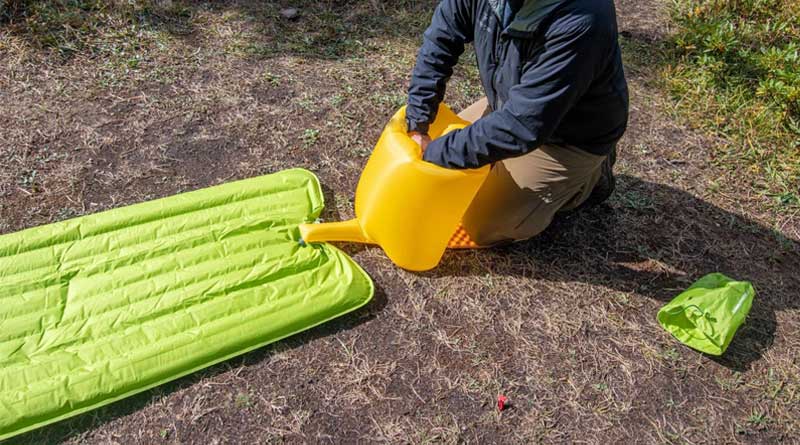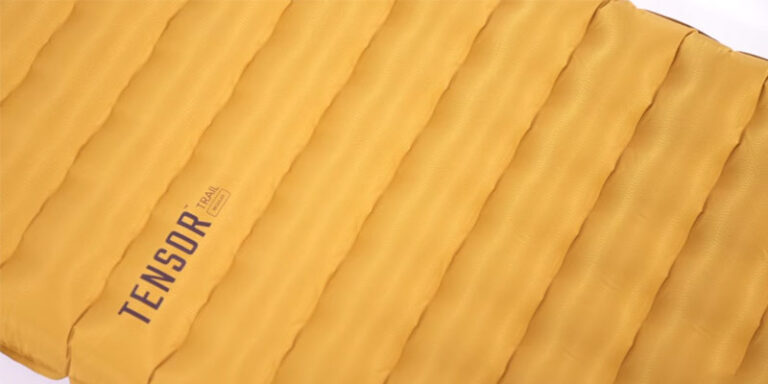A good sleeping mat makes camping more comfortable. It keeps you warm and supports your body while you sleep. The British weather can be cold and damp, so choosing the right mat is important. Some mats are lightweight for backpacking, while others are thicker for extra comfort. There are inflatable, self-inflating, and foam mats, each with pros and cons. Warmth, weight, size, and durability all matter when picking the best one. Whether you camp in summer or winter, the right mat improves sleep. This guide will help you find the best sleeping mat for your needs in the UK.
1. HiiPeak Sleeping Pad

- Weight: 860gm
- Thickness: 8-10cm
- Material: Thermoplastic Polyurethane (TPU)
- Inflation: Built-in foot pump
The HiiPeak Sleeping Pad is an ultralight inflatable mat designed for backpackers and campers who prioritize weight and packability. At just 860g, it’s easy to carry without adding much bulk to your gear. The 6cm thickness provides decent comfort, though side sleepers may find it a bit thin. Made from durable 40D nylon with a TPU coating, it offers good puncture resistance and water resistance. Inflation is quick thanks to the built-in foot pump, removing the need for a separate pump or manual effort.
While it’s a solid choice for summer and mild-weather camping, its insulation is limited, making it less suitable for colder conditions. The pad’s honeycomb air cell design distributes weight evenly, reducing pressure points. However, it may feel a bit narrow for some users, particularly those who move around in their sleep. The deflation process is relatively fast, though it can be tricky to fold back into its storage bag.
Pros:
- Lightweight and compact
- Quick inflation with a foot pump
- Comfortable honeycomb design
- Water-resistant and durable material
Cons:
- Not ideal for cold weather
- Can feel narrow for some sleepers
2. AKSOUL Self-Inflating Sleeping Mat

- Weight: 890gm
- Thickness: 10cm
- Material: Nylon & TPU
- Inflation: 30-40 seconds
The AKSOUL Self-Inflating Sleeping Mat strikes a balance between comfort and convenience. With its self-inflating foam core, setup is effortless—just open the valve and let it expand. At 10cm thick, it provides adequate cushioning and support, though it may not be plush enough for those needing extra comfort. The 190T polyester with a TPU coating ensures durability and water resistance, making it a reliable choice for various terrains.
One of its standout features is insulation, which makes it suitable for three-season camping. However, at 890g, it’s on the heavier side for backpackers who prioritize ultralight gear. Some users may find that the self-inflation process requires a few extra breaths to reach maximum firmness. Packing it down can also take some effort, as the foam needs to be compressed tightly.
Pros:
- Easy self-inflation
- Good durability and water resistance
- Provides decent insulation
- Comfortable for back sleepers
Cons:
- Heavier than inflatable options
- Can take effort to pack down
3. Trekology UL80

- Weight: 560g
- Thickness: 10cm
- Material: 40D Nylon
- Inflation: By mouth
The Trekology UL80 is a well-regarded inflatable sleeping pad that offers an excellent blend of comfort, weight, and packability. At 10cm thick, it provides ample cushioning, making it one of the best options for side sleepers. The 40D nylon material ensures durability while the TPU coating adds water resistance. It comes with a pump sack (sold separately), which speeds up inflation without requiring excessive lung power.
This mat is well-suited for three-season camping, though its insulation might not be sufficient for winter use. It packs down to a compact size, making it convenient for backpacking. However, some users have reported that the valve design can make deflation slightly slower than expected. The pad’s width is also a highlight, offering enough space for most sleepers to move comfortably.
Pros:
- Thick and comfortable, especially for side sleepers
- Lightweight and compact for its size
- Durable, water-resistant material
- Easy inflation with pump sack
Cons:
- Insulation may not be enough for winter
- Deflation can be a bit slow
4. Trail Contour Camping Mat

- Weight: 360gm
- Thickness: 1.5cm
- Material: EVA foam
- Inflation: N/A
The Trail Contour Camping Mat is a dependable choice for campers who value comfort and durability. Its 1.5cm foam core provides good cushioning, while the 75D polyester material ensures longevity. The self-inflating mechanism makes setup convenient, though a few extra breaths may be needed to achieve full firmness.
While the mat offers decent insulation, making it suitable for three-season use, it is slightly heavier than some ultralight inflatable options. The textured surface helps prevent slipping, ensuring a stable sleeping experience. Packing it away requires some effort due to the foam’s bulkiness, but its comfort makes up for it.
Pros:
- Thick and comfortable
- Durable polyester material
- Good insulation for three-season use
- Stable, non-slip surface
Cons:
- Slightly heavy
- Packing it down can take effort
5. Unigear Inflatable Sleeping Pad

- Weight: 507gm
- Thickness: 5cm
- Material: 40D Nylon + TPU
- Inflation: 10-15 breaths
The Unigear Inflatable Sleeping Pad is designed for those who want a lightweight yet comfortable sleeping solution. At 5cm thick, it provides good support, particularly for side sleepers. The 40D nylon and TPU material offer durability and water resistance, making it suitable for various environments. Inflation is easy with the included pump sack, and the deflation process is fairly straightforward.
Its main downside is the insulation, which may not be sufficient for colder temperatures. Additionally, while the material is sturdy, it can be a bit noisy when shifting positions. Despite these minor drawbacks, it remains a great choice for backpackers looking for a comfortable and lightweight mat.
Pros:
- Lightweight and compact
- Comfortable thickness
- Durable and water-resistant
- Quick inflation with pump sack
Cons:
- Insulation could be better
- Can be a bit noisy
6. Trail Self-Inflating Camping Mat

- Weight: 880gm
- Thickness: 2.5cm
- Material: 150D Polyester + Foam
- Inflation: Self-inflating with foam core
The Trail Self-Inflating Camping Mat is a solid choice for those looking for a balance between comfort and affordability. With a 2.5cm foam core, it offers adequate cushioning for most sleepers. The 150D polyester construction enhances durability, and the self-inflating mechanism simplifies setup.
Though comfortable, the mat is on the heavier side, making it less ideal for ultralight backpacking. It provides reasonable insulation for three-season camping but may not be sufficient for extreme cold. Compression for packing requires some effort, but overall, it’s a dependable and budget-friendly option.
Pros:
- Comfortable for back sleepers
- Durable and long-lasting
- Good insulation for three-season use
- Self-inflating for easy setup
Cons:
- Slightly heavy for backpacking
- Can be tricky to pack down
7. Origem Self-Inflating Camping Mat

- Weight: 860gm
- Thickness: 14cm
- Material: 40D Nylon + TPU
- Inflation: Foot Pump
The Origem Self-Inflating Camping Mat offers a reliable combination of comfort and convenience. At 14cm thick, it provides decent support for most sleepers. The 210T polyester material is tough and resistant to wear, while the foam core allows for easy self-inflation.
It’s a great option for those who prefer a bit more cushioning, though it’s not the lightest option available. The insulation makes it suitable for three-season camping. Deflating and packing can be a bit of a process, but its overall durability makes it worth considering.
Pros:
- Comfortable thickness
- Durable material
- Good insulation
- Self-inflating for convenience
Cons:
- Not the lightest option
- Can take effort to pack down
8. MAMBAKOTR Camping Air Bed

- Weight: 850g
- Thickness: 10cm
- Material: 40D Nylon with TPU coating
- Inflation: Built-in foot pump
The MAMBAKOTR Camping Air Bed is a solid choice for campers who value comfort and convenience. The built-in foot pump eliminates the need for an external pump, making setup quick and hassle-free. With a 10cm thickness, it provides excellent cushioning and insulation from cold ground surfaces. The 40D nylon material with TPU coating ensures durability and resistance against punctures, adding to its longevity.
However, despite its impressive comfort level, the air bed is relatively heavier compared to ultralight options, making it less ideal for long-distance backpacking. While the built-in pump is convenient, it takes a bit of effort to fully inflate the mat, which may not be ideal after a long day of hiking.
Pros:
- Thick and comfortable cushioning
- Durable 40D nylon material
- Built-in foot pump for easy inflation
- Good insulation for cold conditions
Cons:
- Slightly heavy for ultralight backpacking
- The inflation process requires some effort
9. NAPASA Camping Mat

- Weight: 1.2kg
- Thickness: 14cm
- Material: 70D Pongee
- Inflation: Pump or Inflate by mouth
The NAPASA Camping Mat is designed for lightweight camping and backpacking, offering a good balance between weight and comfort. Made from 20D ripstop nylon, it is both durable and resistant to minor abrasions. The integrated pillow and built-in hand pump make it convenient for setup and add extra comfort while sleeping. At 6cm thick, it provides sufficient cushioning for most sleepers without adding excessive bulk to a backpack.
While the mat’s ultralight design is a plus, its thinner profile may not be sufficient for side sleepers who need more support. Additionally, the built-in hand pump is slower than traditional inflation methods, requiring multiple presses to fully inflate the pad.
Pros:
- Lightweight and compact design
- Durable ripstop nylon material
- Integrated pillow for extra comfort
- Built-in hand pump for inflation
Cons:
- Not thick enough for side sleepers
- Hand pump takes time to inflate
10. TRINORDIC Ultralight Mat

- Weight: 550g
- Thickness: 5.5cm
- Material: 40D Nylon with TPU
- Inflation: Mouth valve inflation
The TRINORDIC Ultralight Mat is one of the best choices for ultralight backpackers who prioritize weight savings. Weighing just 550g, it packs down small and fits easily in any backpack. The 40D nylon construction makes it durable against wear and tear, and its TPU coating helps resist moisture and prolong the mat’s lifespan. Though only 5.5cm thick, it still provides a decent level of cushioning, especially for back sleepers.
The main drawback is that it relies on mouth inflation, which can be tiring after a long hike. Additionally, while the mat is durable, its lightweight design means it may not be as insulated as heavier alternatives, making it less ideal for cold-weather camping.
Pros:
- Extremely lightweight and compact
- Durable material with TPU coating
- Easy to pack and carry
- Good comfort for back sleepers
Cons:
- Requires manual mouth inflation
- Limited insulation for cold conditions
11. CIXMUS Camping Sleeping Pad

- Weight: 600g
- Thickness: 6.5cm
- Material: 30D Nylon with TPU coating
- Inflation: Integrated foot pump
The CIXMUS Camping Sleeping Pad strikes a balance between weight, comfort, and ease of use. The integrated foot pump makes inflation quick, taking less than a minute to fully inflate the pad. At 6.5cm thick, it provides adequate support for most sleepers, reducing pressure points on the ground. The 30D nylon with TPU coating ensures durability and water resistance.
However, the foot pump requires firm pressure to operate effectively, which may take some getting used to. While suitable for three-season camping, the insulation is not sufficient for winter use in extremely cold conditions.
Pros:
- Quick inflation with foot pump
- Lightweight yet comfortable
- Durable water-resistant material
- Compact storage size
Cons:
- The foot pump requires some effort
- Limited insulation for winter camping
12. POWERLIX Sleeping Pad

- Weight: 600g
- Thickness: 9cm
- Material: 75D Nylon with TPU coating
- Inflation: Inflating Bag
The POWERLIX Sleeping Pad is an excellent choice for budget-conscious backpackers. Made from 75D nylon, it offers impressive durability and abrasion resistance. The hexagonal air cells provide an ergonomic sleeping surface, distributing weight evenly. At only 600g, it is one of the lightest options available, making it ideal for long hikes.
However, since it relies on mouth inflation, filling it up can be exhausting. Additionally, it lacks sufficient insulation for cold weather, making it better suited for warm or moderate climates.
Pros:
- Lightweight and compact
- Highly durable material
- Ergonomic air cell design
- Affordable price
Cons:
- Requires manual inflation
- Limited insulation for cold weather
13. Wilderness Camping Mat

- Weight: 830g
- Thickness: 10cm
- Material: 40D Ripstop Nylon with TPU
- Inflation: Self-inflating
The Wilderness Camping Mat is a comfortable and reliable option for campers who don’t mind carrying a bit of extra weight. Its 10cm thickness ensures excellent cushioning, and the 40D ripstop nylon provides strong durability. The built-in foot pump makes inflation easy, eliminating the need for external pumps.
Despite its comfort, the mat’s heavier weight may not appeal to ultralight backpackers. Additionally, it is bulkier than some of the other mats on this list when packed down.
Pros:
- Thick and supportive padding
- Durable ripstop nylon material
- Built-in foot pump for easy setup
- Good for three-season camping
Cons:
- Heavier than ultralight mats
- Bulkier when packed
14. iNeibo Sleeping Pad

- Weight: 830g
- Thickness: 8cm
- Material: 30D Nylon with TPU
- Inflation: Built-in Foot Pump
The iNeibo Sleeping Pad is a solid mid-range option, offering a good balance between weight and comfort. Its 8cm thickness provides adequate support, and the 30D nylon material enhances durability. The pad is compact and easy to carry, making it a great choice for hikers.
The biggest drawback is the Built-in Foot Pump inflation, which can take some effort. Additionally, it does not offer as much insulation as heavier mats.
Pros:
- Lightweight and compact
- Comfortable thickness
- Durable 30D nylon material
- Affordable price
Cons:
- Requires manual inflation
- Limited cold-weather insulation
How to Choose a Sleeping Mat in the UK?
A good sleeping mat can make a big difference when camping. It provides comfort, insulation, and support for a better night’s sleep. In the UK, the weather can be unpredictable, and the ground can be cold and damp. Choosing the right sleeping mat is essential to stay warm and comfortable.
Types of Sleeping Mats
There are different types of sleeping mats available. The most common ones are foam mats, self-inflating mats, and air mats. Each type has its pros and cons.
- Foam mats are lightweight and affordable. They are made from closed-cell foam and provide basic insulation. These mats do not require inflation and are very durable. However, they can be bulky and less comfortable than other options.
- Self-inflating mats have a foam core that expands when you open the valve. They offer a balance of comfort, insulation, and convenience. They are more compact than foam mats but slightly heavier. These mats are ideal for those who want good insulation without carrying too much weight.
- Air mats are filled with air and provide the most comfort. They are very lightweight and pack down small. However, they require inflation, which can take time. Some air mats have built-in insulation to keep you warm. They are great for backpacking but can be expensive and prone to punctures.
Choosing the Right Insulation
Insulation is important when choosing a sleeping mat, especially in the UK’s colder climate. Mats have an R-value, which measures how well they insulate. The higher the R-value, the warmer the mat.
For summer camping, an R-value of 1 to 2 is usually enough. If you camp in spring or autumn, look for a mat with an R-value of 2 to 4. For winter camping, you need a mat with an R-value of 4 or higher. Some mats use synthetic or down insulation to improve warmth. Others use reflective materials to trap body heat.
Comfort and Thickness
Comfort depends on the thickness and material of the mat. Thicker mats provide more cushioning, making them better for side sleepers. However, they can be heavier and take up more space. A mat that is at least 5 cm thick is usually comfortable for most people.
The surface texture of the mat also affects comfort. Some mats have a soft fabric top, while others have a smooth plastic surface. A non-slip surface can help keep your sleeping bag in place.
Size and Weight
Size and weight are important if you are carrying the mat in a backpack. A lightweight mat is easier to carry but may be less comfortable. Air mats are usually the lightest, while foam mats are the heaviest.
Most mats come in standard, wide, and long sizes. If you are tall, check the length of the mat before buying. Some mats taper at the feet to save weight, but this may reduce comfort. If you move a lot in your sleep, a wider mat can be a good choice.
Ease of Use
Some mats are easier to set up than others. Foam mats are the easiest because they do not need inflation. Self-inflating mats need a few minutes to expand, but you may need to add some extra air.
Air mats require inflation, which can be done by mouth, pump, or built-in pump sack. If you camp often, a mat with a quick-inflate valve can save time. Deflating the mat should also be easy, especially if you need to pack up quickly.
Durability and Maintenance
Durability is important, especially for air mats. Foam mats are the most durable because they cannot be punctured. Self-inflating mats are also strong, but the foam inside can wear out over time.
Air mats are the most delicate. Sharp objects can puncture them, so carrying a repair kit is a good idea. Some mats have thicker materials or reinforced areas to reduce the risk of damage.
Cleaning and storing the mat properly will make it last longer. Store self-inflating and air mats with the valve open to keep the foam inside in good shape. Wipe down the mat after each trip to remove dirt and moisture.
Price and Budget
Sleeping mats come in different price ranges. Foam mats are the cheapest, usually costing between £10 and £30. Self-inflating mats range from £30 to £100, depending on quality and insulation. Air mats can cost anywhere from £50 to over £200.
If you camp often, investing in a good mat is worth it. A cheap mat may not last long or provide enough comfort. However, there are budget-friendly options that offer good value.
Best Sleeping Mats for Different Uses
If you are a backpacker, an ultralight air mat is the best choice. Look for one that packs small and has good insulation. If you are a car camper, comfort is more important than weight. A thick self-inflating mat or a large air mat can provide the best sleep.
For winter camping, choose a mat with a high R-value. Some winter mats combine foam and air for extra warmth. If you camp in wet conditions, a waterproof mat with a non-slip base is a good idea.
Final Thoughts
Choosing the right sleeping mat depends on your needs and budget. Think about the type of camping you do and the weather conditions. A good sleeping mat will help you stay warm, comfortable, and well-rested on your trips. Take your time to find the best one, and enjoy your outdoor adventures in the UK.



